Goldfish (Carassius auratus) have long been one of the most popular and beloved fish among aquarists. These fascinating creatures were instrumental in the development of aquarium keeping as a hobby. In this article, we explore the history of goldfish breeding, offering insights into their care, feeding, and how to breed them successfully. You will also find descriptions of the various goldfish breeds, complete with photos and a summary of their distinctive features.
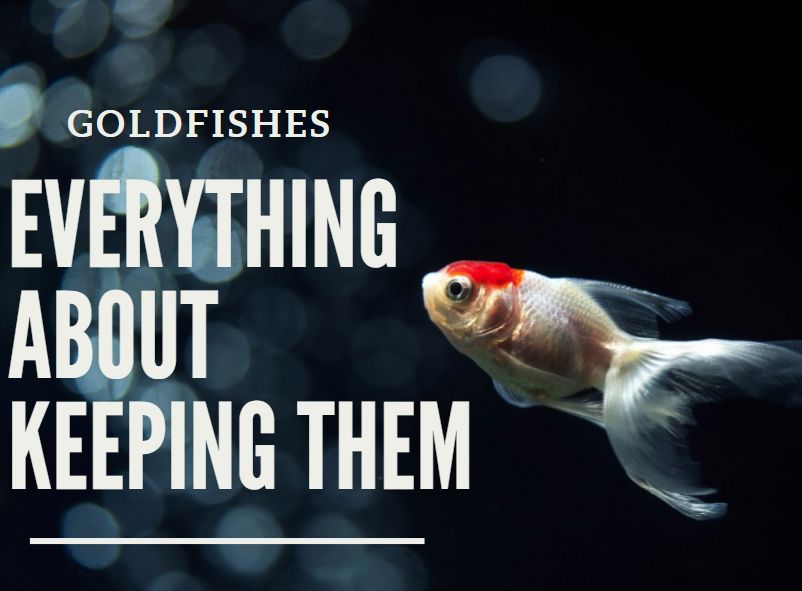
Contents
Goldfish breeds
First of all, all breeds can be divided into two large groups: those with long and short bodies. Fish with elongated body (comet, shubunkin, wakin and, of course, common goldfish) due to their body shape are the closest to their historical and genetic ancestor – golden carp. As a rule, only their fins are modified, sometimes the modification is rather significant.
As for the fish with short bodies, this is their body shape that has been essentially transformed if compared to the original one.
All these together with modified fins, eyes, outgrowths on a head stipulated higher demands of these species and the fact that they are more prone to various infections.
Common goldfish

Goldfish typically reach up to 30 cm in length, though when kept in a pond, they can grow as large as 45 cm and weigh up to 1.5 kg. Their size is influenced by factors such as the size of the tank or pond, their diet, and the water temperature. Goldfish have an elongated body that closely resembles their ancestor, the common carp. Most commonly, they display a bright red-orange coloration, though red and white varieties are also quite common.
| Characteristic | Description |
|---|---|
| Scientific Name | Carassius auratus |
| Size | Varies based on breed, but typically 6 to 10 inches (15-25 cm) in length. Some can grow much larger in suitable environments. |
| Lifespan | 10 to 20 years on average, but can live longer with proper care. Some goldfish have been known to live up to 30 years or more. |
| Shape | Elongated body with a rounded belly and tapered tail fin. |
| Coloration | Wide variety of colors and patterns, including orange, red, white, black, yellow, and more. |
| Fins | Typically have two pectoral fins, two pelvic fins, two anal fins, one dorsal fin, and a caudal fin (tail fin). |
| Eyes | Bulging eyes on the sides of the head. |
| Habitat | Freshwater environments like ponds, aquariums, and slow-moving rivers. Goldfish are hardy and adaptable. |
| Temperament | Generally peaceful, social, and friendly with other non-aggressive fish. Can be interactive and recognize their owners. |
| Feeding | Omnivorous diet, consuming both plant matter and small aquatic creatures. Goldfish flakes, pellets, vegetables, and live/frozen foods are suitable. |
| Tank Requirements | Need a spacious aquarium with adequate filtration and regular water changes. A larger tank is better to accommodate their potential size. |
| Temperature Range | Prefer a water temperature between 65°F to 75°F (18°C to 24°C). |
| Water pH Range | Tolerant of a wide pH range, but usually thrive between 6.0 to 8.0. |
| Breeding | Goldfish are egg-layers, and breeding can occur in captivity under certain conditions. They do not provide parental care. |
| Common Health Issues | Prone to swim bladder disorders, parasites, bacterial infections, and fungal diseases. Overfeeding can lead to health problems. |
| Special Considerations | Avoid keeping goldfish in small bowls, as they require ample space to grow and thrive. Provide adequate filtration and maintain water quality. |
Comet goldfish
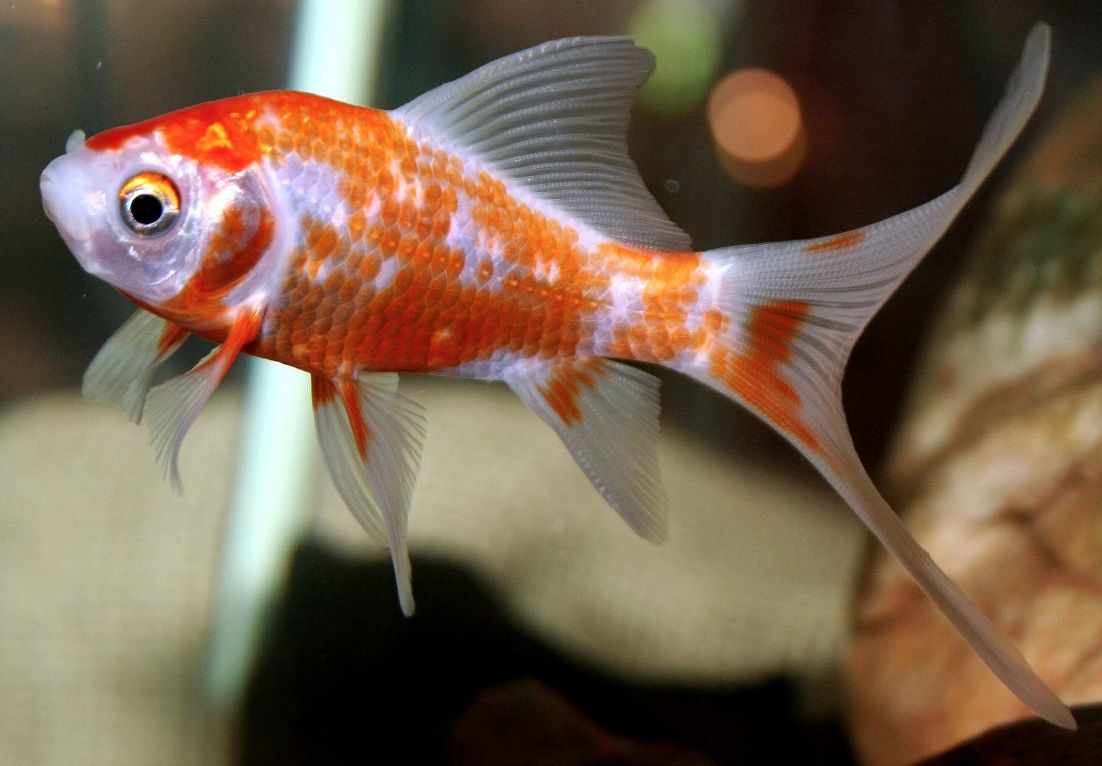
The comet goldfish is an active and lively breed known for its elongated body, which can grow up to 18 cm in length. Its appearance is reminiscent of the common gold carp, yet the comet is distinguished by its vibrant coloring and longer fins.
Comets are categorized based on their fin types: the common comet, which features an elongated tail fin, and veiltail variations, which have both elongated fins and tails. Some thoroughbred representatives can have tail lengths that are three to four times the length of their bodies, making them particularly striking.
Due to their energetic nature, comets thrive in spacious tanks that allow for plenty of swimming. For those considering adding comets to their aquarium, it’s essential to provide a well-maintained environment to support their lively temperament.
| Characteristic | Description |
|---|---|
| Common Name | Comet Goldfish |
| Scientific Name | Carassius auratus |
| Origin | United States |
| Size | Up to 12 inches (30 cm) in length |
| Lifespan | 10 to 15 years (can live longer with proper care) |
| Body Shape | Elongated and streamlined, resembling a comet |
| Fin Configuration | Single dorsal fin, paired pectoral, pelvic, and anal fins |
| Coloration | Various colors, including red, orange, yellow, white, and black |
| Tail Shape | Long, forked tail (comet-shaped) |
| Behavior | Active and fast-swimming; may leap out of the water |
| Ideal Water Temperature | 65°F to 75°F (18°C to 24°C) |
| Water pH Level | 6.0 to 8.0 |
| Water Hardness | 5 to 20 dGH (soft to moderately hard water) |
| Minimum Tank Size | 30 gallons for a single fish, larger for multiple fish |
| Diet | Omnivorous, eats flakes, pellets, and live/frozen foods |
| Tank Environment | Provide hiding spots, plants, and open swimming areas |
| Compatibility | Generally peaceful, but avoid mixing with fin-nipping fish |
| Tank Maintenance | Regular water changes and filtration are essential |
Shubunkin goldfish
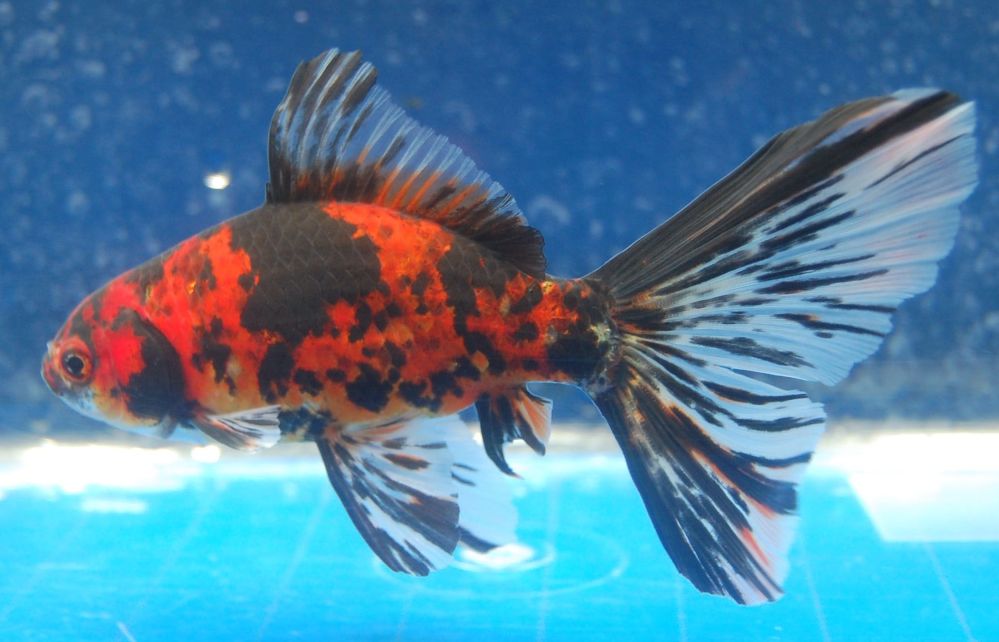
In Europe and the USA, there are three recognized breed standards for shubunkin goldfish: American, Bristol, and London. While these standards represent distinct variations, they all share the hallmark of striking calico coloring, which has become the most notable feature of this breed. Over time, selective breeders have incorporated calico patterns into other goldfish varieties, including those with shorter bodies.
In terms of temperament, shubunkins are significantly calmer than comets, making them well-suited for community tanks. Their peaceful nature allows them to coexist with other goldfish, both elongated and some short-bodied varieties.
For aquarists considering shubunkin goldfish, it’s essential to provide a spacious tank with clean water and adequate filtration.
| Characteristic | Description |
|---|---|
| Origin | Japan |
| Size | 6 to 10 inches (15 to 25 cm) |
| Lifespan | 10 to 15 years or longer with proper care |
| Body Shape | Elongated and streamlined, similar to a common goldfish |
| Body Color | Varied and vibrant colors with speckles and patches |
| Finnage | Long, flowing fins with a mix of colors |
| Tail Types | Double tail or single tail with broad, sweeping fins |
| Pattern Variations | Calico-like patterns, often described as mottled |
| Temperament | Generally peaceful and social, can be kept in groups |
| Coldwater Fish | Requires cool water temperatures between 65-75°F (18-24°C) |
| Tank Size | Minimum 20-gallon tank for a single fish |
| Water Conditions | Neutral pH (around 7.0), well-filtered and well-oxygenated water |
| Diet | Omnivorous – Pellets, flakes, veggies, and live/frozen foods |
| Tank Setup | Plenty of open swimming space and hiding spots |
| Water Hardiness | Tolerates a range of water conditions |
| Breeding | Egg-layers, breed in ponds with plants or spawning mops |
| Health Concerns | Prone to swim bladder issues and respiratory problems |
| Special Considerations | Avoid sharp decorations that may tear delicate fins |
Wakin goldfish
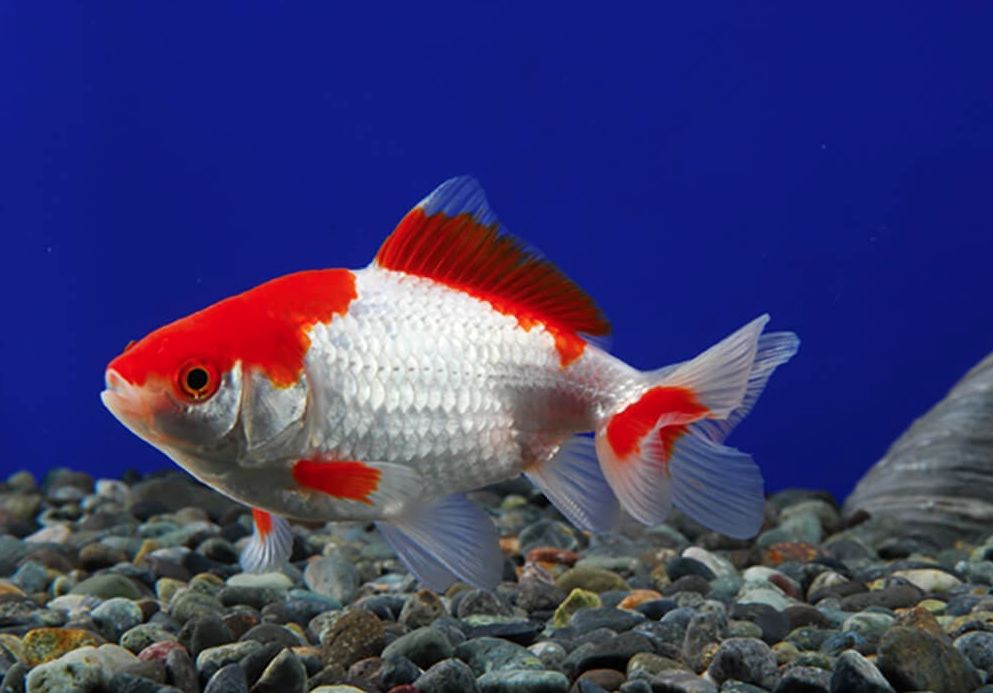
The wakin goldfish, also known as Japanese goldfish, is distinguished by its claw-ended tail, setting it apart from more common varieties. Considered a prototype for many short-bodied goldfish types with similar tail shapes, the wakin typically grows up to 30 cm in length, making it more suitable for outdoor ponds than for traditional aquariums.
While the wakin is popular in certain regions, it lacks standardization in the USA and UK, which can lead to variations in breeding practices. Its unique tail shape contributes not only to its aesthetic appeal but also to its graceful swimming style.
For those considering keeping wakin goldfish, it’s important to provide ample space and a clean environment, as these fish thrive best in larger bodies of water. Overall, the wakin goldfish offers a striking addition to any pond, combining beauty and elegance.
| Characteristic | Description |
|---|---|
| Origin | Japan |
| Size | Medium to large; typically 8 to 18 inches (20 to 45 cm) |
| Body Shape | Elongated and robust |
| Tail Shape | Double tail with broad lobes |
| Coloration | Various colors and patterns (red, white, orange, etc.) |
| Eye Placement | Protruding eyes |
| Fins | Long, flowing fins |
| Behavior | Active and hardy fish |
| Temperature Range | 65°F to 75°F (18°C to 24°C) |
| Water Conditions | Prefer freshwater with good filtration |
| Diet | Omnivorous; eat both plant matter and small insects |
| Lifespan | 10 to 20 years or more with proper care |
| Tank Size | Larger tanks are preferable due to their size |
| Tank Mates | Peaceful community fish; avoid fin nippers |
Fantail goldfish
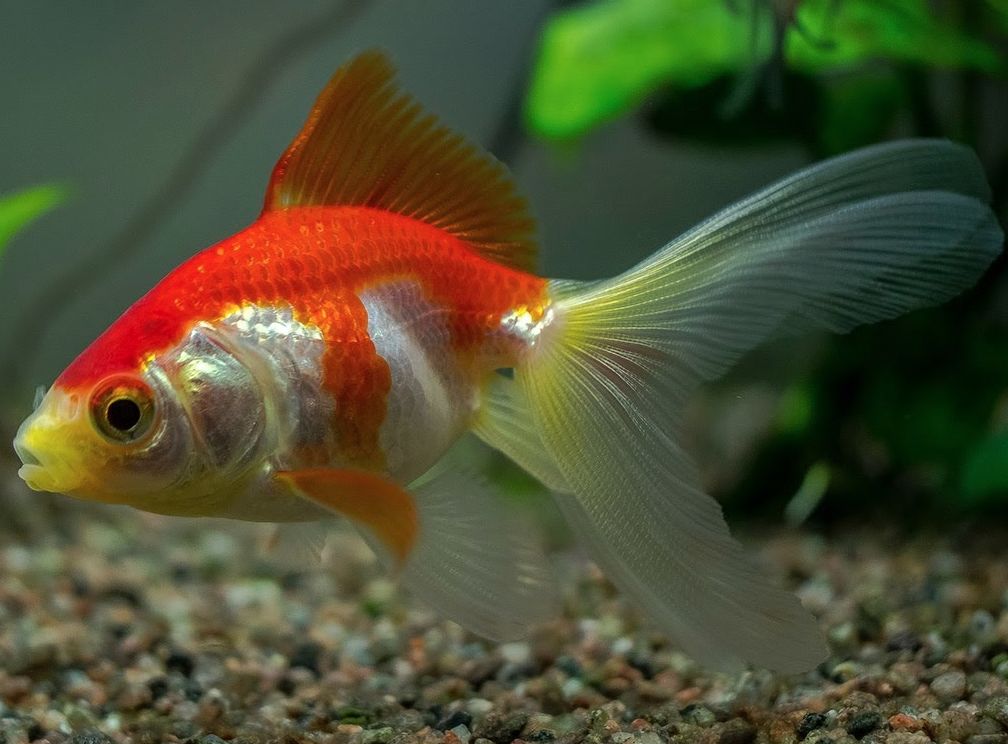
The fantail goldfish is a visually striking breed known for its slightly elongated, rounded body and distinctive claw-ended tail fin. This variety can showcase a wide range of colors, including red, red-orange, two- and three-color combinations, calico, and pink. Notably, calico varieties may display a metallic sheen on some of their scales, enhancing their overall appeal.
Fantails are popular among aquarists not only for their beauty but also for their graceful swimming style. When keeping fantail goldfish, it’s essential to provide a spacious tank with clean water and gentle filtration, as they can be sensitive to water quality.
| Characteristic | Description |
|---|---|
| Body Shape | Short, rounded body with a double caudal fin |
| Tail Type | Double tail (butterfly-shaped) |
| Coloration | Various colors and patterns |
| Eyes | Bulging and positioned on the sides of the head |
| Size | Can grow up to 6-8 inches (15-20 cm) |
| Lifespan | 10-15 years or more |
| Temperament | Peaceful and social |
| Feeding | Omnivorous, eats fish flakes, pellets, and live/frozen foods |
| Tank Size | Requires a spacious tank due to its double tail and potential size |
| Water Conditions | Prefers clean, well-filtered water |
| Temperature Range | 65°F to 78°F (18°C to 26°C) |
| pH Range | 6.0 to 8.0 |
| Compatibility | Generally compatible with other goldfish varieties, avoid mixing with aggressive fish |
Ryukin goldfish
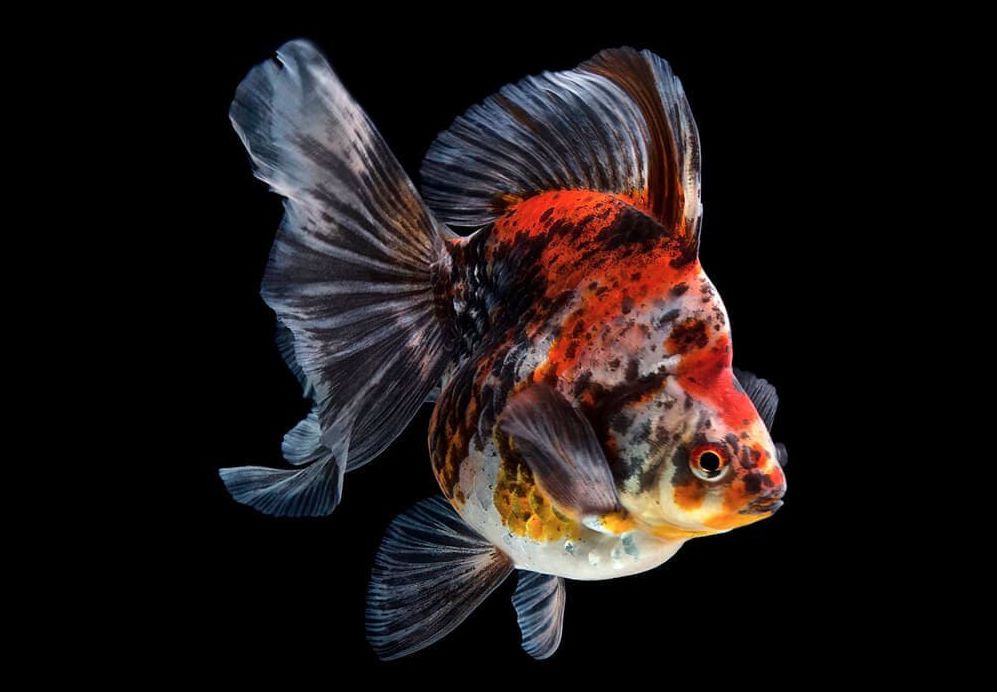
The ryukin goldfish, a breed developed in Japan, is often regarded as a prototype of the fantail variety. Its body is distinctly rounded, short, and swollen, giving it a unique and charming appearance. One of the most notable features of the ryukin is its “hood,” which extends from its large head down to the tail fin, enhancing its striking profile. The ryukin also has slightly bulging eyes, adding to its character.
Coloration varies widely among ryukins, with popular hues including solid red, two- and three-color combinations, pink, and calico patterns. These vibrant colors make the ryukin a favorite among aquarists.
When keeping ryukin goldfish, it is important to provide a spacious tank with clean water and gentle filtration. Their rounded body shape may make them more susceptible to certain health issues, so regular monitoring and care are essential for their well-being.
| Characteristic | Description |
|---|---|
| Origin | Japan |
| Body Shape | Compact and egg-shaped body with a humpbacked appearance |
| Size | Medium to large-sized fish, typically reaching 6 to 8 inches (15 to 20 cm) in length |
| Coloration | Wide variety of colors and patterns, including solid colors, calico, metallic, and variegated |
| Fins | Double caudal (tail) fin with a split and fan-like appearance, long flowing dorsal and anal fins |
| Eyes | Protruding and large eyes that are characteristic of fancy goldfish |
| Head Growth (Nuchal Hump) | Prominent nuchal hump on the back of the head, more pronounced in mature males |
| Swimming Behavior | Active and agile swimmers, but may have slower mobility due to their body shape |
| Temperament | Generally peaceful and can be kept with other non-aggressive goldfish |
| Care Difficulty | Moderate; requires clean water, appropriate filtration, and regular maintenance |
| Lifespan | 10 to 15 years, or even longer with proper care |
Veiltail goldfish
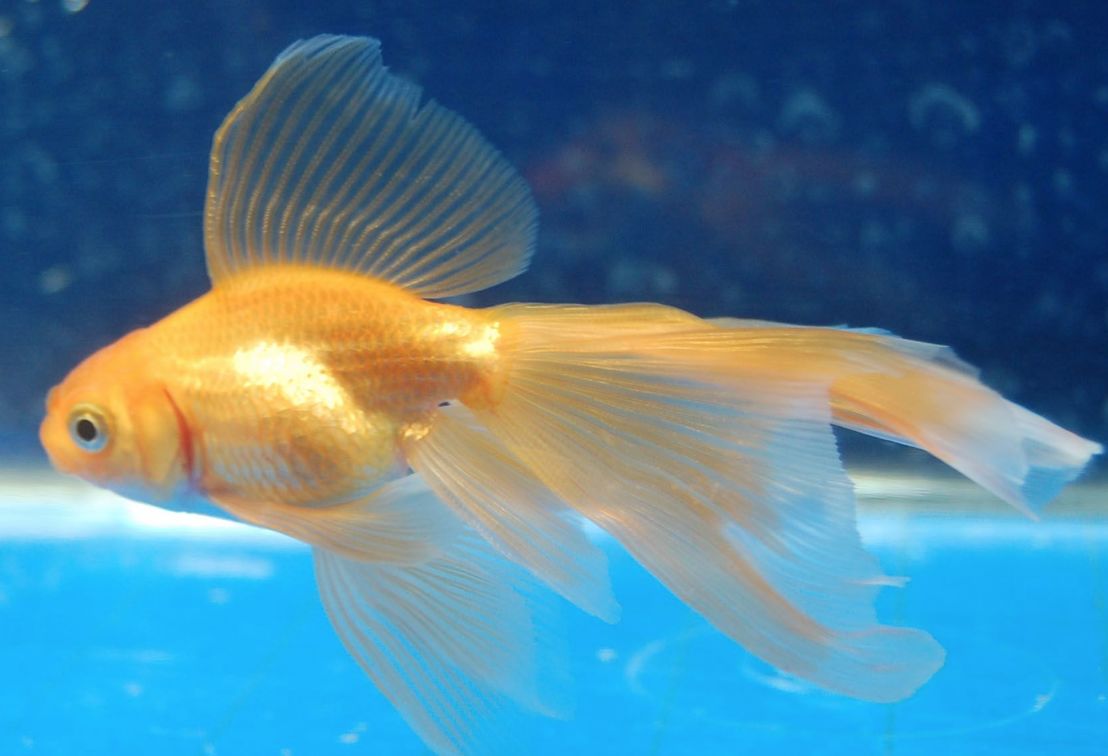
The veiltail goldfish is a highly appealing breed known for its calm demeanor and graceful swimming style. With a rounded body that can grow up to 20 cm long, it is often considered a direct descendant of the ryukin goldfish. The most striking feature of the veiltail is its exceptionally long fins, particularly its tail fin, which adds to its elegant appearance.
This breed’s serene nature makes it a popular choice for community tanks, but it requires careful consideration in tank setup. Providing ample swimming space and a peaceful environment will help ensure the veiltail thrives. Due to its long fins, it is important to maintain clean water and avoid sharp decorations that could damage its delicate fins.
| Characteristic | Description |
|---|---|
| Body Shape | Elongated body with a single caudal fin |
| Tail Type | Long, flowing and feathery veil-like tail |
| Tail Length | Typically longer than the body |
| Dorsal Fin | Long, flowing dorsal fin |
| Colors | Various colors, including orange, red, white, etc. |
| Size | Can grow up to 6-8 inches (15-20 centimeters) |
| Lifespan | Usually 10-15 years, but can live longer with care |
| Temperament | Generally peaceful and social |
| Care Difficulty | Moderate, requires a well-maintained aquarium |
| Water Parameters | Temperature: 65-72°F (18-22°C); pH: 6.0-8.0 |
| Tank Size | At least 20 gallons for a single Veiltail |
| Feeding | Omnivorous, diet includes pellets, flakes, and veggies |
| Tank Decoration | Avoid sharp objects to prevent tail damage |
| Common Health Issues | Swim bladder problems, fin rot, and constipation |
Telescopic eye goldfish

This goldfish breed is distinguished by its large, prominent eyes, which can measure up to 5 cm in diameter. The shape and orientation of these eyes vary significantly, with forms ranging from spherical to cylindrical and conical. Often, the axis of each eye is perpendicular to the surface of the fish’s head, and they may be oriented in different directions.
These protuberant eyes are a defining characteristic of the breed, consistently passed down to offspring, even when breeding occurs with other goldfish varieties. This unique trait not only enhances the fish’s visual appeal but also requires careful attention in terms of tank conditions and care. Ensuring a stable environment is crucial for maintaining the health of these sensitive eyes, as any abnormalities can impact the fish’s ability to see and feed properly.
| Characteristic | Description |
|---|---|
| Scientific Name | Carassius auratus |
| Common Name | Telescope Eye Goldfish |
| Origin | China |
| Adult Size | Up to 6-8 inches (15-20 cm) |
| Lifespan | 10-15 years or more in proper care |
| Body Shape | Elongated oval with a slightly compressed body |
| Eyes | Prominent and protruding eyes |
| Eye Position | Eyes point upward and outward from the head |
| Eye Vision | Poor eyesight, nearsighted, poor depth perception |
| Finnage | Double caudal (tail) fin, paired pectoral fins |
| Colors | Various colors and patterns, including red, white, black, orange, calico, etc. |
| Scales | Metallic or nacreous scales |
| Behavior | Generally peaceful, social and friendly |
| Ideal Tank Size | 20 gallons or more for one goldfish, additional 10 gallons per additional fish |
| Water Conditions | pH: 6.0-8.0, temperature: 65-72°F (18-22°C), clean and well-filtered water |
| Diet | Omnivorous, will eat both plant matter and small aquatic organisms |
| Feeding | Small frequent feedings, avoid overfeeding |
| Tank Decorations | Soft, rounded objects to prevent eye injury, avoid sharp decorations |
| Tank Mates | Peaceful, non-nipping fish; avoid long-finned species |
| Common Health Issues | Swim bladder problems, eye injuries, and infections |
| Special Considerations | Fragile eyes prone to injury, avoid bright lights |
| Breeding | Egg-laying species, requires specific conditions for breeding success |
Oranda goldfish

This goldfish breed is characterized by fleshy outgrowths on its head and the upper sides of its gill covers, often accompanied by long, flowing fins. These outgrowths can vary significantly in shape and color, sometimes covering just the top of the head or extending over the entire head, potentially obscuring the fish’s eyes.
Aquarists and breeders often categorize subvarieties based on the type of outgrowths. For example, the “pompom” variety features outgrowths limited to the nose, while the “lionchu” has outgrowths that uniformly cover the entire head. These distinctions not only enhance the breed’s visual appeal but may also influence care considerations, such as ensuring clear visibility and monitoring for potential health issues related to the growths.
| Characteristic | Description |
|---|---|
| Origin | China |
| Size | Medium to Large (6 to 12 inches or 15 to 30 centimeters) |
| Body Shape | Egg-shaped with a rounded, large belly |
| Wen (Head Growth) | Prominent, fleshy growth on the top of the head |
| Coloring | Wide variety of colors including red, orange, black, white, calico, etc. |
| Fins | Flowing and long, typically paired with a split caudal (tail) fin |
| Eyes | Protruding eyes that may appear telescope-like |
| Scales | Metallic and reflective, overlapping |
| Temperament | Generally peaceful and sociable |
| Swimming Behavior | Slower and less agile compared to other goldfish types |
| Lifespan | 10 to 15 years or more with proper care |
| Tank Size | Requires a spacious aquarium due to their size and need for swimming space |
| Water Conditions | Prefers clean and well-maintained water |
| Feeding | Omnivorous, will eat a variety of foods including pellets, flakes, and fresh vegetables |
| Tank Mates | Compatible with other peaceful goldfish varieties |
| Special Considerations | Careful maintenance of the wen to prevent infections |
Lionchu and Ranchu goldfishes
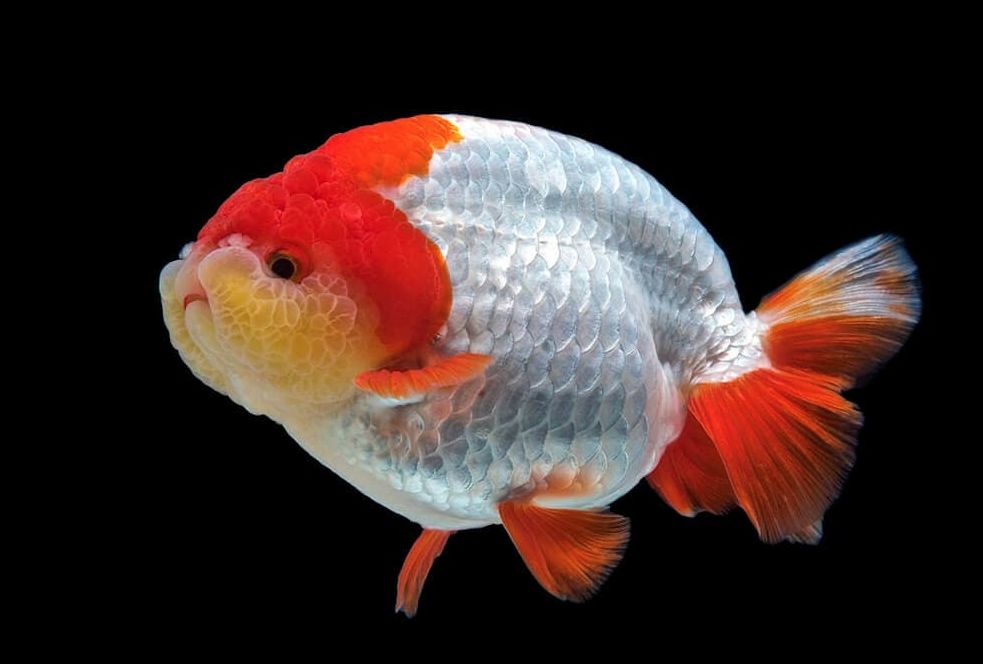
Although the lionchu and ranchu breeds are very similar in appearance, aquarists from the UK and USA distinguish them based on a few key differences. The lionchu is known for its more pronounced head outgrowths, especially on the sides of its face, giving it a more dramatic appearance compared to the ranchu.
The ranchu, on the other hand, has a more curved back, and its tail fin has a distinctive 45º upward angle from the base of its body. In contrast, the lionchu’s back is straighter, and its tail fin extends more smoothly from the back, creating a continuous line along its body contour.
These subtle physical differences not only give each fish its own aesthetic appeal but can also influence their movement and care needs. For example, the larger head growth on the lionchu may require more attention to prevent health issues, while the ranchu’s more curved back can affect how it swims.
| Characteristic | Description |
|---|---|
| Origin | Japan |
| Size | Small to medium-sized (up to 8 inches / 20 cm) |
| Body Shape | Egg-shaped body with a pronounced hump (headgrowth) on the back of the head |
| Tail Shape | Double tail, short and rounded |
| Finnage | Short and stubby fins |
| Colors | Various colors and patterns, commonly red, white, black, and calico |
| Eyes | Large and protruding |
| Swimming Ability | Moderate swimmers due to their body shape |
| Care Difficulty | Moderate |
| Lifespan | 10 to 15 years or more |
| Tank Size | 20 gallons per fish minimum |
| Water Conditions | Temperature: 65°F to 75°F (18°C to 24°C) |
| pH: 6.5 to 7.5 | |
| Ammonia and nitrite should be kept at zero | |
| Diet | Omnivorous, a balanced diet of pellets, flakes, and occasional live/frozen foods |
| Tank Set-up | Provide ample space and hiding spots |
| Use fine sand or rounded gravel as substrate | |
| Regular water changes are crucial | |
| Compatibility | Peaceful, but avoid housing with aggressive tankmates |
| Common Health Issues | Swim bladder problems, fin rot, and fungal infections |
| Special Considerations | The hump on the head can grow with age and may require additional care |
Pearlscale goldfish
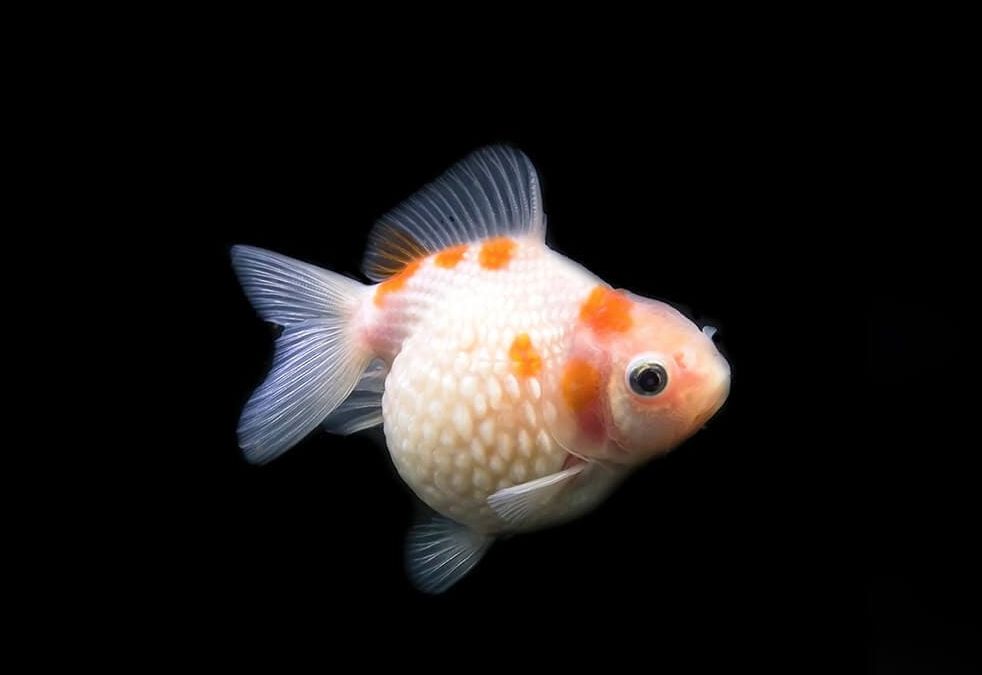
The pearlscale goldfish is known for its distinctive, egg-shaped body, which can grow up to 15 cm in length. Its short pectoral and lateral fins add to its unique appearance, but what truly sets it apart are its bulbous, pearl-like scales. These scales, resembling halves of a pearl, give the fish a textured, gem-like look.
Despite its beauty, the pearlscale is not recommended for beginner aquarists. It is highly sensitive to water quality and requires pristine tank conditions. Clean water, free from ammonia and nitrites, is essential to prevent health issues. The fish is particularly prone to infectious diseases, so maintaining a stable, well-filtered environment with regular water changes is critical.
For experienced aquarists, the pearlscale’s unusual appearance can be a rewarding challenge, but its care demands constant attention and careful water monitoring.
| Characteristic | Description |
|---|---|
| Body Shape | Round, egg-shaped body |
| Scale Appearance | Domes or raised bumps (like pearls) on the scales |
| Scale Coloration | Can vary widely, including metallic, red, white, etc. |
| Fins | Typically have short, stubby fins |
| Size | Medium-sized, reaching around 5-7 inches (12-18 cm) |
| Lifespan | 10 to 15 years or more with proper care |
| Temperament | Generally peaceful and social |
| Swimming Behavior | Slower, less agile swimmers compared to some breeds |
| Tank Size | Minimum 20-gallon tank for one Pearlscale |
| Water Conditions | Prefer stable, clean water with a pH of 6.5 to 8 |
| Water Temperature | 65°F to 75°F (18°C to 24°C) |
| Diet | Omnivorous, will eat both plant and animal matter |
| Feeding Habits | May need special care due to their body shape |
| Breeding Difficulty | Moderate, requires controlled breeding conditions |
| Common Health Issues | Prone to swim bladder problems due to body shape |
| Unique Feature | Distinctive domed scales giving a “pearly” appearance |
Celestial Eye goldfish
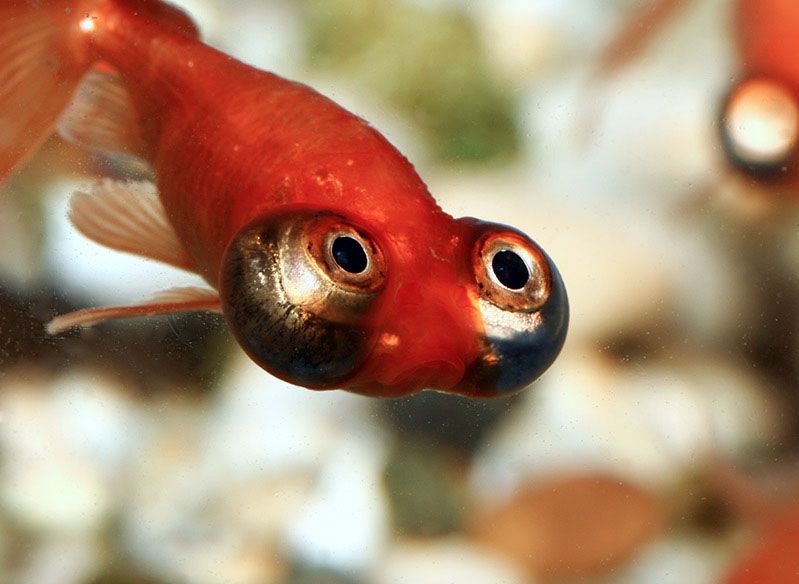
The celestial eye goldfish, also known as the stargazer goldfish, is a striking and distinctive variety. Its most notable feature is its upward-facing, telescope-like eyes, which give it a unique stargazing appearance. Unlike most goldfish, the celestial eye lacks a dorsal fin, and its anal and tail fins end in delicate, claw-like shapes.
Because of its upward-directed eyes, the celestial eye goldfish often faces challenges when navigating its environment and feeding. It is also more vulnerable to injury and infection, making it a more demanding breed for aquarists. The absence of a dorsal fin affects its swimming stability, so it requires a calm, obstruction-free tank with soft or smooth decorations to prevent damage to its sensitive eyes.
Overall, the celestial eye goldfish is best suited for experienced aquarists who can provide a safe, carefully maintained environment to accommodate its delicate features.
| Characteristic | Description |
|---|---|
| Common Name | Celestial Eye Goldfish |
| Scientific Name | Carassius auratus |
| Origin | China |
| Size | Small to medium-sized, typically 6-8 inches (15-20 cm) |
| Lifespan | 10-15 years |
| Body Shape | Egg-shaped with a protruding, upward-looking pair of eyes |
| Eye Placement | Eyes are directed upward, giving a “stargazing” appearance |
| Eye Characteristics | Large, protruding, and often telescope-like appearance |
| Color Varieties | Wide range of colors, including red, orange, white, black, etc. |
| Finnage | Double-tail or twin-tail, long flowing fins |
| Water Temperature | 65°F to 78°F (18°C to 26°C) |
| Water pH | 7.0 to 8.4 |
| Tank Size | Minimum 20 gallons for a single fish, larger for multiple |
| Tank Environment | Freshwater, well-filtered, with hiding spots and smooth substrate |
| Diet | Omnivorous, eats both commercial fish flakes and live/frozen foods |
| Temperament | Peaceful and social, can be kept with other peaceful fish |
| Special Considerations | Delicate eyes, avoid sharp or rough tank decorations |
Bubble Eye goldfish
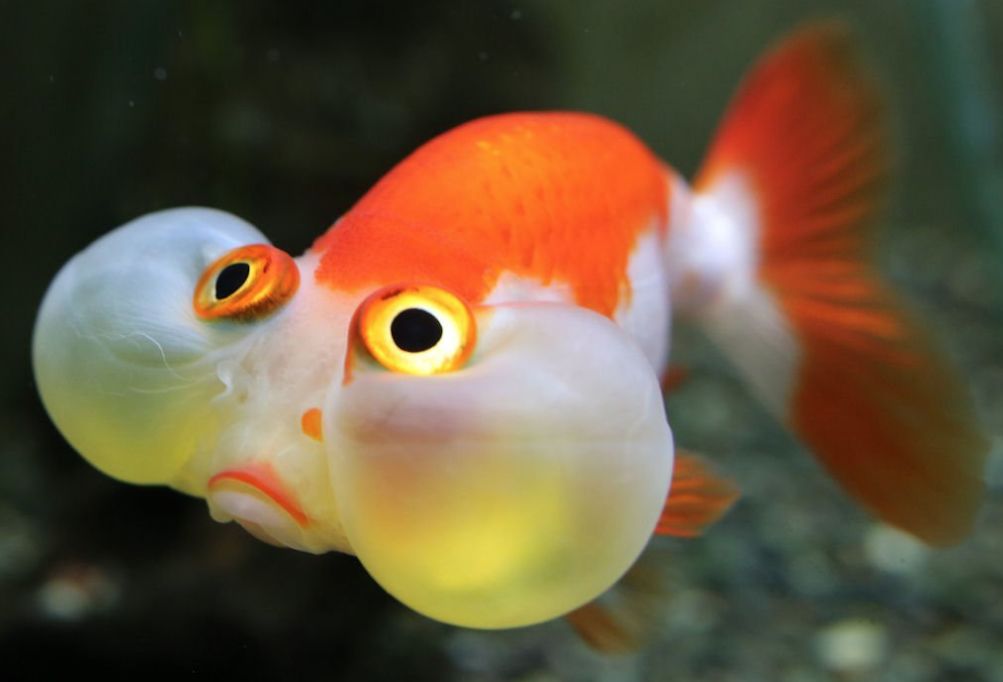
The bubble eye goldfish resembles other short-bodied goldfish breeds in shape and fins, but it stands out due to its large, forward-facing optic vesicles. These “bubbles” on either side of its head are fluid-filled sacs, making the bubble eye a highly delicate fish. Any mechanical action, such as rough tank decorations or accidental bumps, can easily damage these sensitive sacs.
Because of their vulnerability, bubble eye goldfish require special care. Their susceptibility to bacterial and fungal infections further complicates their care, making them a poor choice for beginner aquarists. Even slight water quality fluctuations can trigger health problems in these fish, so maintaining a stable and clean environment is crucial.
For experienced aquarists, a bubble eye goldfish’s tank should be free of sharp or rough objects, with smooth surfaces to avoid damaging the bubbles. Soft filtration and calm tank mates, if any, are essential to ensuring their well-being.
Due to their delicate nature, bubble eye goldfish demand more attention and care than many other breeds, and their susceptibility to disease makes them a challenging but rewarding fish for advanced keepers.
| Characteristic | Description |
|---|---|
| Appearance | Rounded body with flowing, long fins |
| Eye Bubbles | Large, fluid-filled sacs under each eye |
| Color | Wide range of colors, including red, orange, black, etc. |
| Size | Typically 6 to 8 inches (15 to 20 cm) in length |
| Lifespan | 10 to 15 years with proper care |
| Temperament | Generally peaceful and gentle |
| Tank Size | Preferably 20 gallons per fish (or more) |
| Tank Environment | Smooth surfaces to prevent injuries from sharp objects |
| Water Conditions | Clean, well-filtered water with regular water changes |
| Temperature Range | 68°F to 74°F (20°C to 24°C) |
| Feeding | Omnivorous; diet includes pellets, flakes, and veggies |
| Special Considerations | Extremely delicate fins and eye sacs prone to damage |
| Avoid housing with aggressive or fin-nipping fish | |
| Requires careful handling and maintenance |
History of goldfish appearance
When the fish was first mentioned
The history of goldfish breeding stretches back centuries, with their earliest ancestors found in Asia. The common carp (Cyprinus carpio) is believed to be the forerunner of modern goldfish. Over a thousand years ago, in China and Korea, people not only captured fish but also began breeding them on fish farms.
Through years of selective breeding, Chinese fish farmers encouraged natural mutations that drastically altered the fish’s body shape, fins, skin texture, and eye structure. These changes also resulted in the creation of ornamental fish species and color variations that form the basis of the goldfish varieties we know today.
The first record of a red-scaled goldfish comes from the Jin dynasty (265–420 A.D.) in China. These fish were reportedly observed in a pond near Lushan Mountain in the Red River district, close to present-day Shaanxi province. While early writings, such as the Shan Hai Jing, reference a ‘red carp,’ it is unclear whether these wild species were the direct ancestors of modern goldfish.
It is believed that the distinctive red coloring of goldfish emerged during the Tang dynasty (618–907 A.D.) through targeted selective breeding. Some historians suggest that the spread of Buddhism in the region played a role in preserving fish with unusual features. For humanitarian reasons, “abnormal” or uniquely shaped fish were spared and placed into special fish farms or ponds, eventually finding their way into ornamental containers.
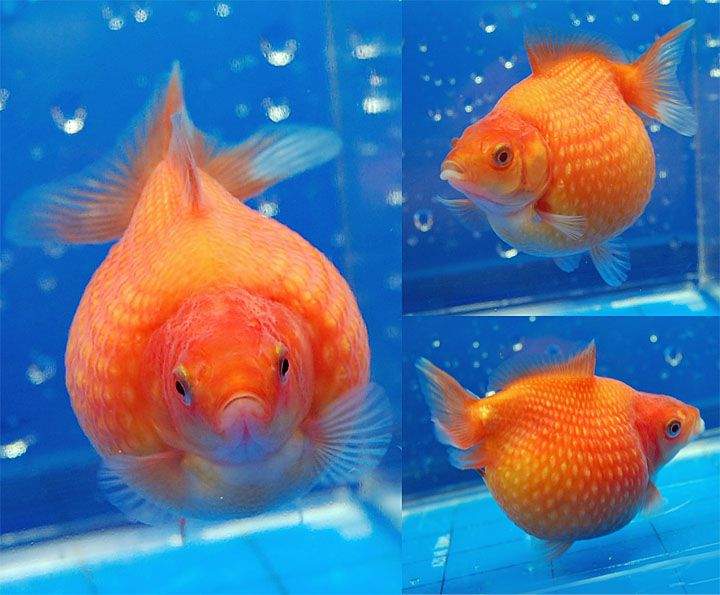
How the first breeds appeared
After the 960s, during the Song dynasty, goldfish, along with other animals, became popular pets kept in home pools. This period marks the beginning of their domestication. Initially, goldfish were a decoration for the wealthy, whose large estates allowed for private pools and fountains. The growing popularity of goldfish led to a flourishing breeding and trade industry, and by the 13th century, new subspecies had emerged.
Over time, goldfish began to spread beyond the homes of the rich. From the 13th to the 16th century, they gradually moved into more modest homes, where they were kept in small ponds and wooden tubs. These tubs eventually evolved into spherical clay vats, followed by more refined ceramic and porcelain vases designed for wealthier households.
In 1369, Chinese emperor Hongwu initiated the production of large porcelain containers to house captive fish. These early aquariums, often referred to as “fish ponds” or “dragon’s vases,” were relatively large, with wide openings that allowed people to observe the fish from above—similar to a pond view. This encouraged breeders to develop fish varieties that were especially appealing when viewed from the top.
The elegant porcelain vases came in various shapes such as ovals, spheres, and barrels, and were adorned with intricate paintings and plasterwork. These containers were often set on stands or legs styled as animal paws or fish fins, showcasing the craftsmanship involved in their creation. Though some vases included sand or plants at the bottom, most were left empty, housing just one or a few goldfish for display.
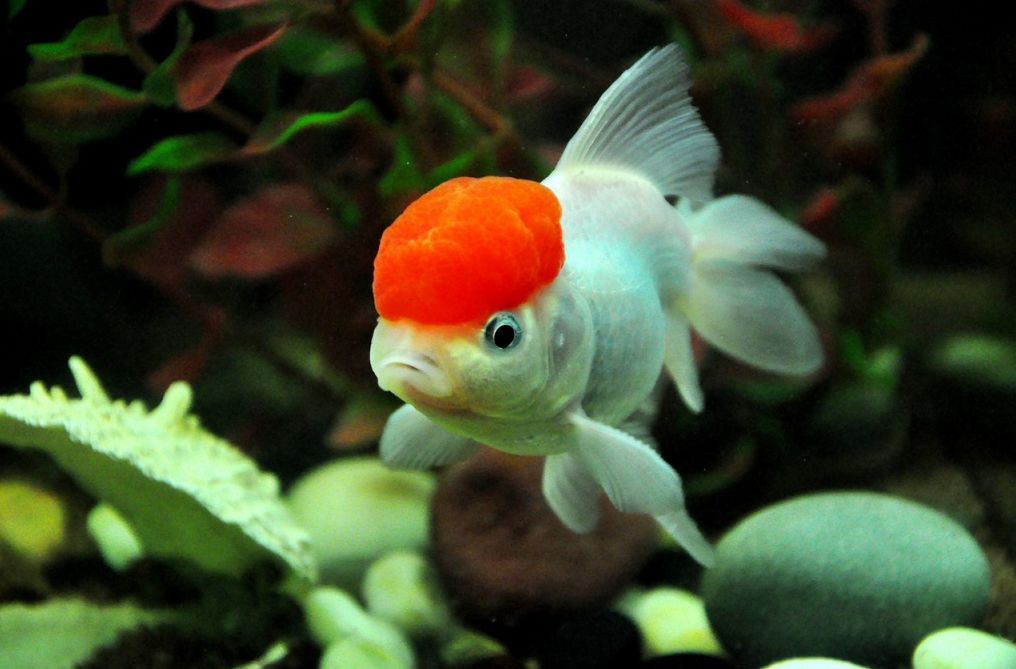
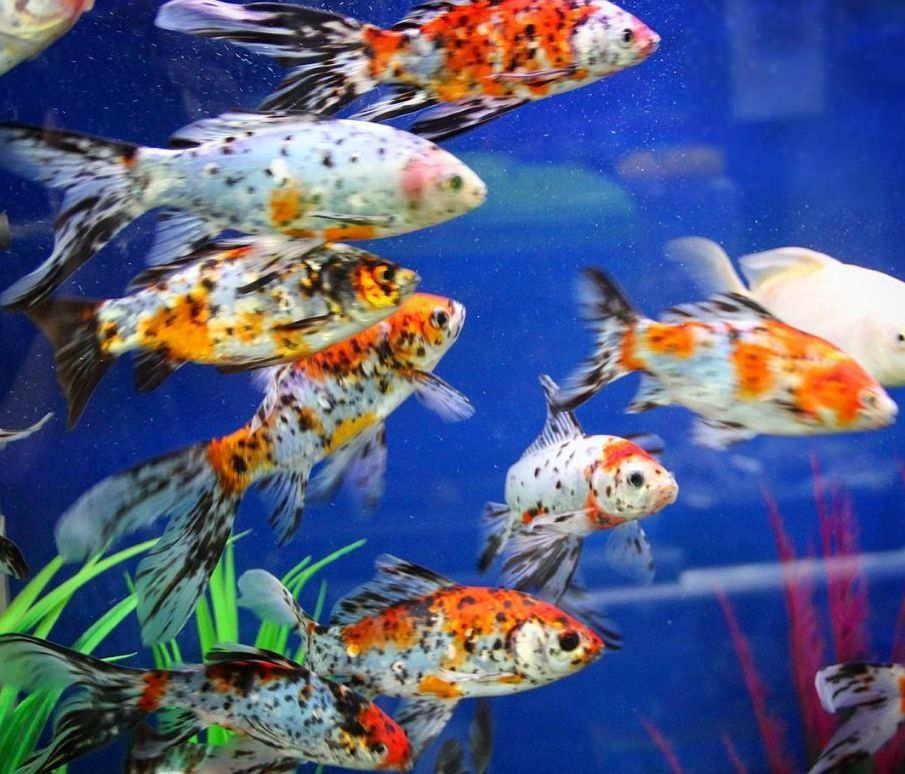
Care and keeping in a tank
Keeping fish in a tank can be straightforward if you follow a few essential guidelines: provide a spacious tank, avoid overcrowding, ensure the tank has effective filtration and aeration, and perform regular partial water changes.
Water temperature
Fish generally prefer cooler water, but they may not always thrive when the temperature is around 18–20°C (65–68°F), especially if they have been bred in captivity. Some varieties, such as pearlscale, ranchu, and lionchu, are considered heat-loving species and prefer slightly warmer conditions.
You can maintain the water temperature between 22–25°C (72–77°F), adjusting it based on how your fish respond. However, be cautious, as temperatures that are too high can accelerate the aging process in fish.
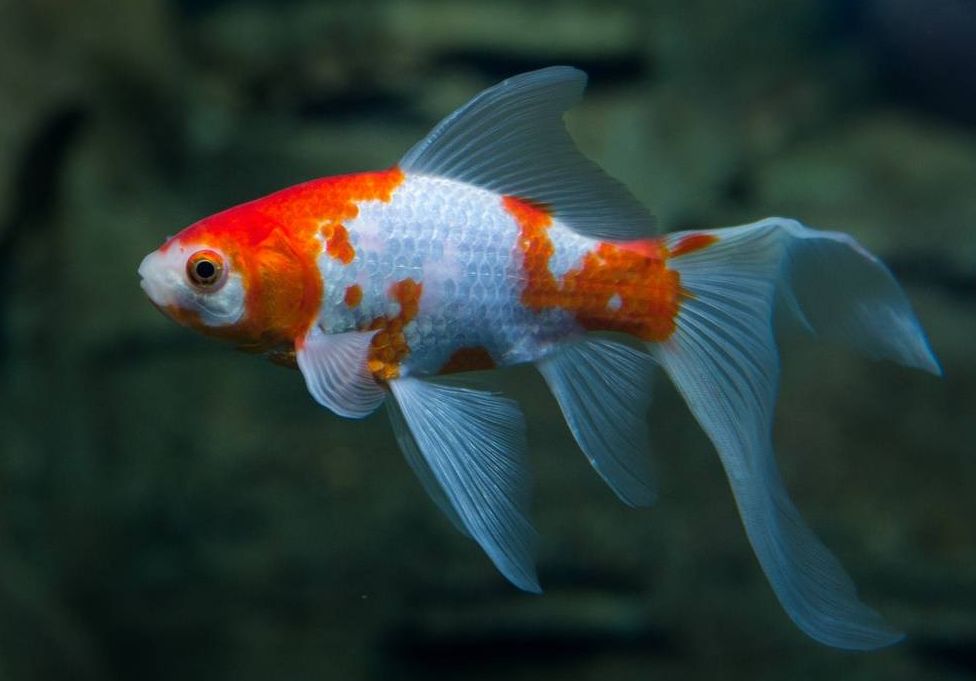
Volume of the tank
One of the most critical factors in keeping goldfish is ensuring the right tank size and stocking density. While it is technically possible to keep goldfish in small tanks, we strongly advise against it.
For those who already have three fish in a 30-liter (6.5-gallon) tank with no immediate chance of upgrading or rehoming the fish, the best solution is to either get a larger tank or consider keeping a different species. Keeping goldfish in such small conditions is likely to harm both the fish and your experience as a fishkeeper.
There are many other fish species that thrive in smaller tanks and would find your setup quite spacious. However, if your heart is set on goldfish, you must invest in a larger tank.
While some sources claim that fish can live comfortably in small tanks, experience shows otherwise. Beginner aquarists who attempt to keep goldfish in small tanks often encounter frequent issues, leading to the premature death of their pets. Fish survival in such cramped conditions is the exception rather than the rule.
If you insist on keeping goldfish in a small tank, it requires a high level of expertise, time, and careful maintenance. Fish in small tanks are at a higher risk of disease due to the increased likelihood of poor water quality.
For goldfish, the recommended tank size is at least 50 liters (11 gallons) per fish, with a minimum of 100 liters (22 gallons) for a pair. This ensures they have enough space to swim freely, even with tank mates. Once the tank volume increases, you can consider adding more fish, but avoid overcrowding, which is easy to do with goldfish.
The strict requirements for tank size stem from two factors. First, many goldfish from Southeast Asia are raised in ponds and struggle to adapt to much smaller environments. Second, their tendency to overeat and their unique digestive system place a significant biological load on the tank, producing large amounts of waste. If the waste exceeds the tank’s capacity to maintain balance, it can lead to harmful conditions and even death.
Additionally, overcrowded tanks can stunt the growth of young fish, causing deformities and increasing their susceptibility to disease—a condition known as “pulling.”
The ideal tank shape is one that is roughly twice as long as it is wide. Tanks with water column heights over 50 cm should be avoided, as they are more difficult to maintain and may limit plant growth, as light will struggle to reach the bottom layers.
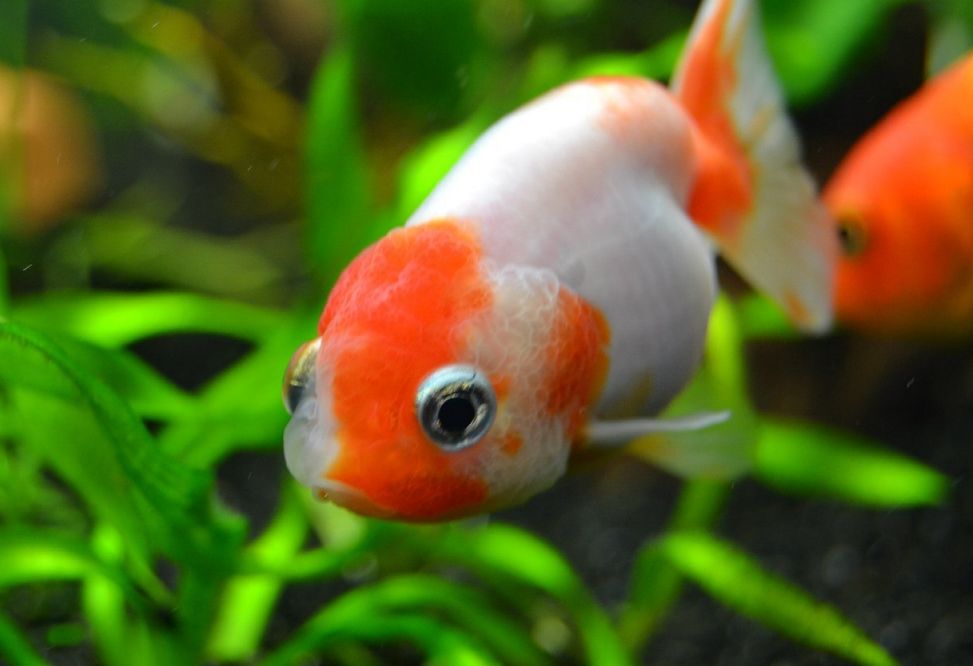
Tank decoration
When decorating your goldfish tank, it’s crucial to consider the specific species that will inhabit it. If you plan to keep varieties like the telescope, bubble eye, or celestial eye, avoid decorations with sharp edges, including stones and substrate, as well as plants with sharp leaves. These fish are particularly prone to injury due to their delicate eyes and fins.
Ensure that all tank elements, such as rocks, shells, and driftwood, are smooth and free of rough or pointed surfaces. Sharp objects can easily injure or tear the fish’s fins, leading to complications.

Aquarium plants and goldfishes
Adding live plants to your goldfish tank is highly recommended. Plants improve water quality, help control algae, enhance the tank’s appearance, and provide a natural addition to the fish’s diet.
However, many aquarists face the challenge of goldfish eating most plants, which can quickly turn a lush tank into a barren one. This is actually a good reason to include plants that are “tasty” for your fish, as they can diversify the diet, offer extra vitamins, and keep your fish engaged.
Additionally, there are plenty of hardy or less palatable plants, such as large or coarse-leaved varieties, that goldfish tend to leave alone. These plants will thrive and contribute to the ecological balance in the tank.
To prevent the fish from uprooting plants while digging in the substrate, you can secure the roots by placing smooth, rounded pebbles around them.
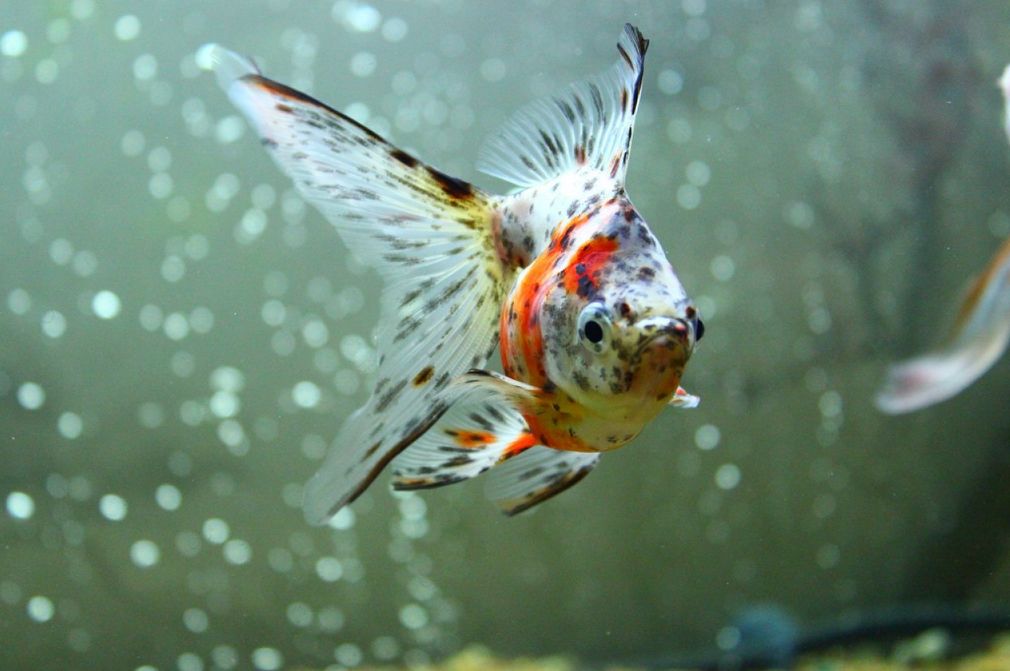
Bottom substrate
Choosing the proper substrate for your aquarium is important, especially if you’re keeping fish that enjoy digging. A substrate with a grain size of 3-5 mm is generally suitable for most tanks. However, it’s important to be aware that digging fish might accidentally pick up small stones, which could get stuck in their mouths under certain conditions.
Some aquarists recommend opting for either larger or finer-grained substrate to minimize this risk. That said, such incidents are quite rare, so your main concern should be ensuring the substrate has no sharp or jagged edges, which can harm the fish.
If a fish does happen to get a stone lodged in its mouth, you may need to carefully remove it using forceps or toothpicks.
Filtration
Goldfish are known for producing a significant amount of organic waste, both due to their physiology and their natural tendency to dig in the substrate. This waste can quickly accumulate, making a reliable internal filter essential for maintaining water quality through mechanical filtration.
In a goldfish tank, regular maintenance is critical. The filter media should be rinsed with tank water during routine water changes to prevent clogging without disrupting beneficial bacteria. It’s also important to keep the filter running continuously, day and night, to ensure optimal water circulation and purification.
Lifespan
The lifespan of goldfish can vary greatly depending on factors such as breed, tank conditions, care, tank mates, and diet. While it is true that the exact lifespan is difficult to determine, goldfish are known for living quite long when properly cared for. In an ideal environment, with excellent water quality and nutrition, they can live anywhere from 5 to 30 years.
In large ponds with cooler water temperatures, some larger breeds, such as the comet or shubunkin, can even surpass 30 years. The key to ensuring a long and healthy life for your goldfish lies in consistent care and maintaining stable water conditions.

Feeding
Feeding goldfish can be challenging for new aquarists because these fish are known for their gluttonous behavior and constant search for food. Their eagerness can often mislead beginners into overfeeding them, but it’s essential to follow a controlled feeding schedule. Feed goldfish small portions once or twice a day, ensuring that they consume all the food within 5-10 minutes. If feeding twice a day, offer smaller portions to avoid overfeeding.
Overfeeding is one of the most common issues with goldfish and can lead to digestive problems, such as gastrointestinal diseases. To prevent this, it’s important to maintain a balanced and varied diet. Goldfish are omnivorous, so their diet should include both plant-based and animal-based foods. Live food, like bloodworms or daphnia, can be part of their diet, though it carries the risk of introducing infections to the tank. Frozen food is a safer alternative in this regard, as it minimizes the risk of contamination.
In addition to live and frozen foods, vegetable matter is crucial for goldfish. You can offer them vegetables like lettuce, cucumber, and cabbage, which should be boiled and chopped before feeding. Adult goldfish can even eat lettuce leaves without boiling. Plants like lemna, riccia, and hornwort are also good options, with hornwort being especially beneficial because it absorbs excess nitrates from the water.
If you are going away for a short period and cannot feed your goldfish, adding a bunch of hornwort to the tank will provide them with a food source and help maintain water quality.
Before feeding dry food like flakes or pellets, soak them in tank water for a few minutes to prevent the food from swelling in the fish’s stomach, which can lead to digestive issues. When offering frozen food, make sure it’s thawed to room temperature and never refreeze it once thawed. If feeding juveniles frozen brine shrimp, it’s a good idea to soak the shrimp in water to remove excess salt.
By offering a balanced and varied diet, you can ensure the health and longevity of your goldfish.
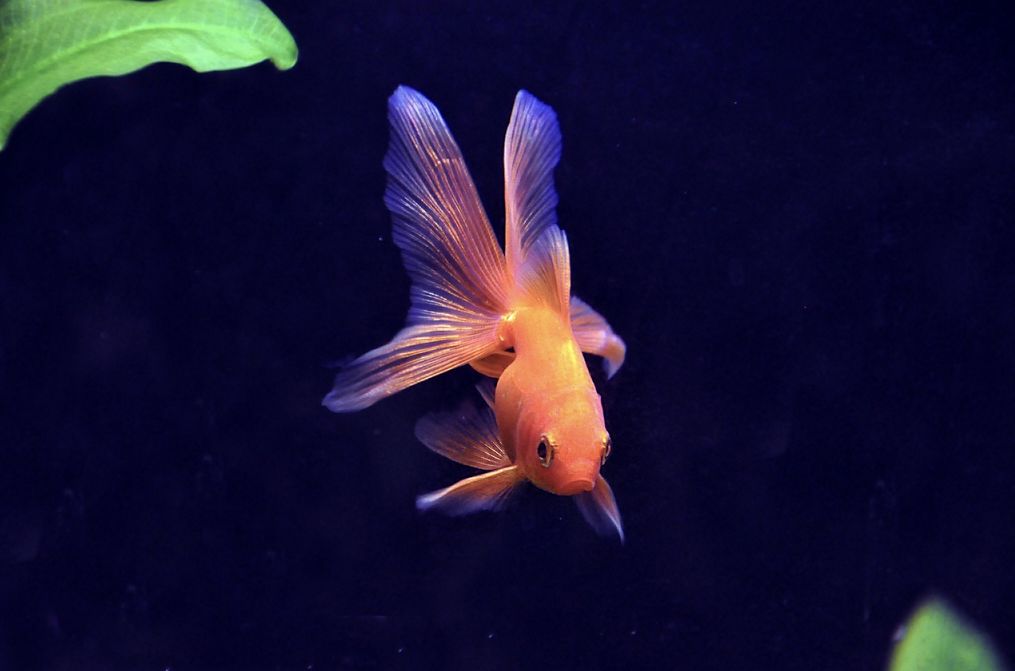
Compatibility and tank mates
Not all goldfish breeds are compatible with one another, and in some cases, it’s best to house certain breeds separately, even from their own relatives. This is particularly true for breeds with distinct body shapes, such as elongated and short-bodied varieties.
Goldfish with elongated bodies, such as the common goldfish, comet, and shubunkin, are generally more active and tend to grow larger, sometimes reaching over 30 cm (12 inches) without including their tail fin. These fish thrive in ponds due to their size and need for space. If kept in a tank, it should be at least 200 liters to allow them enough room to swim comfortably.
Because of their active nature, elongated-bodied goldfish should be kept separate from short-bodied breeds, which tend to be less active. Short-bodied goldfish, such as the telescope, ryukin, and fantail, are more delicate. For example, the telescope’s poor vision and clumsiness can leave it struggling to compete for food, while its vulnerable eyes can be injured by faster or more aggressive tank mates. The same applies to celestial eye goldfish.
The bubble eye breed is also at risk, as its delicate “bubbles” can be easily damaged by other fish, either accidentally or intentionally. Among the short-bodied varieties, the ryukin and fantail are generally the most hardy and beginner-friendly. However, more delicate breeds like the oranda, celestial eye, ranchu, lionhead, pearlscale, and bubble eye are best suited for experienced aquarists.
When it comes to tank mates, the general rule is that goldfish are not compatible with most other fish. Even smaller fish, like guppies, have been known to nip at the fins of large, slow-moving goldfish, while goldfish themselves will eagerly eat anything they can fit in their mouths. Additionally, goldfish have specific requirements for water temperature and diet, making it difficult to pair them with most ornamental fish.
One possible exception is peaceful, undemanding catfish species, which can help keep the tank clean. However, even with catfish, caution is needed. For example, there have been reports of bristlenose plecos feeding on goldfish, particularly short-bodied varieties, and even nipping at their sides down to the bone.
Overall, careful planning and attention to compatibility are crucial when setting up a tank for goldfish.